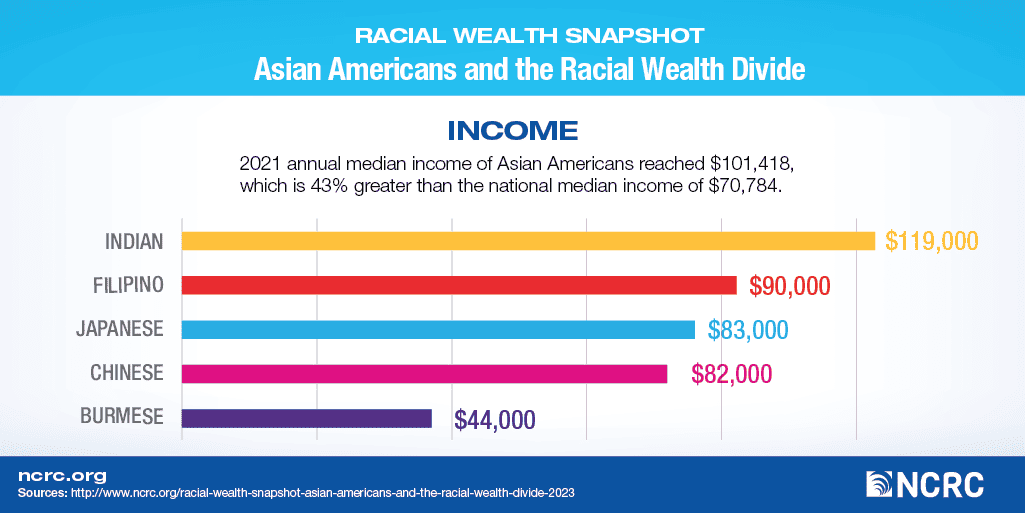The Asian American and Latino American communities are often essentialized down to preconceived notions about “the immigrant experience.” But treating these communities as monoliths or strictly as ‘immigrant communities’ hides their true diversity and obscures valuable lessons about how wealth-building operates for each.
Asian Americans, a rapidly growing immigrant group, come from diverse backgrounds across Southeast, South, East and Central Asia. Our newly updated racial wealth snapshot on the Asian-American and Pacific Islander (AAPI) community details some of that diversity.
In 2019, about 6 in 10 Asian Americans were foreign-born, making immigrants the majority. Chinese Americans are the largest group, numbering 5.4 million. The Indian, Filipino and Vietnamese communities are the next-largest cohorts. Asian Americans make up 7.3% (around 24 million) of the total US population, projected to reach 46 million by 2060.
Latino Americans, hailing from the predominantly Spanish and Portuguese speaking countries of Latin America, are the second largest racial or ethnic group in the US at 19%. This large and diverse ethnic group encapsulates a variety of races and national origins, with Latino individuals with origins in Mexico making up the largest community at 37 million in 2021, followed by the Puerto Rican, Salvadoran, Cuban and Dominican communities. Latino Americans as a whole make up 62.5 million people, 4 out of 5 of which are American citizens as of 2021.
Despite strides in economic progress, Asian Americans show significant diversity in wealth. While the median household wealth of Asian Americans is $206,400, numerous subgroups such as Burmese Americans experience negligible wealth accumulation. AAPI immigrants entering through refugee status tend to have lower income or wealth compared to those arriving on higher-paying work visas. This challenges the “model minority myth,” which assumes higher socioeconomic achievement among AAPI communities.
There are significant income disparities between Asian American subgroups, stemming from both the nature of different groups’ immigration patterns and the differences in educational attainment between them. For instance, Indian Americans make the highest median income of $119,000. The success of Indian immigrants can be attributed to a strict selection process in immigration policy, where education is most valued. Around 77% of Indian American adults have a college degree in comparison to only 29% of all immigrants.
The Indian American economic experience contrasts sharply with that of Southeast Asians, one of the largest immigrant refugee populations. Americans of Southeast Asian heritage have significantly lower income levels. Originating from Vietnam, Cambodia and Laos, these immigrants fled wars and crumbling regimes. Out of 2.5 million Southeast Asian Americans, nearly 1.1 million are low income and 460,000 live in poverty. In education, they had the lowest high school and college graduation rates. Variations in immigration experiences and educational achievements translate into different economic and social situations.
Like the Asian American community, the Latino American community has a variety of wealth outcomes based on national origin – detailed here in our newest racial wealth snapshot on Latinos’ economic experience.
Those with origins in Columbia had the highest median wealth in the Latino community at $141,200, while individuals with origins in the Dominican Republic had the lowest median wealth at $9,430. As a whole, however, the Latino community falls short of both the median non-Latino and non-Latino White wealth values. There is a common misconception that this wealth gap is driven by immigration status. Indeed, 44% of US immigrants have Latino origins and the majority of the US unauthorized immigrant population comes from Latin American countries. But a majority of the Latino community is actually born in the United States, with about 80% of Latino Americans being US citizens as of 2021. Only around 13% of all Latinos in the US are undocumented and only 33% of all Latinos are born outside of the US. This indicates that the White-Latino wealth gap is structural, rather than simply down to immigration patterns.
Latinos in the US also have dealt with a history of discrimination that has blocked the wealth building opportunities that the non-Latino White community has enjoyed. A report from Brookings found that Latinos also have different approaches to wealth building that has allowed the wealth divide to persist, such as holding assets with less value than White-owned assets. The Latino community is also not immune to the core drivers of overall racial wealth inequality in the US, with racial identification playing a significant factor in employment, income and homeownership. White-identifying Latinos having generally higher incomes and homeownership rates than Black-identifying Latinos. Consistent gaps in wealth between racial subgroups of the Latino community speak to the fact that America has yet to truly address the root causes of these wealth disparities, and viewing the Latino community solely as an immigrant community robs many of a long history and struggle in America that they deserve recompense for.
A nuanced understanding of racial and economic inequality must recognize the immense diversity within Asian and Latino communities. Both communities share histories of discrimination and differing approaches to wealth building that perpetuate persistent gaps. Acknowledging the multifaceted struggles and contributions within these groups is essential for a more equitable and inclusive society moving forward.
Dylan Gardner and Maya Kurani were NCRC interns.
Dedrick Asante-Muhammad is NCRC’s Chief of Organizing, Policy and Equity.



